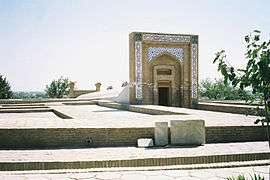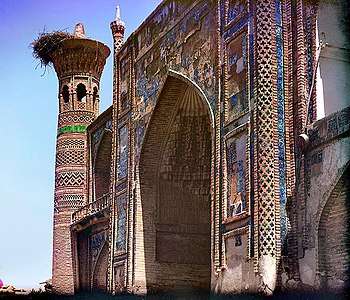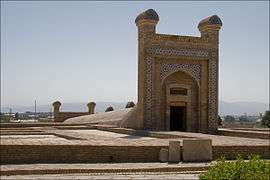Ulugh Beg Observatory


The Ulugh Beg Observatory is an observatory in Samarkand, Uzbekistan. Built in the 1420s by the Timurid astronomer Ulugh Beg, it is considered by scholars to have been one of the finest observatories in the Islamic world.[1] Some of the famous Islamic astronomers who worked at the observatory include Al-Kashi, Ali Qushji, and Ulugh Beg himself. The observatory was destroyed in 1449 and rediscovered in 1908.
History and astronomical equipment
In 1420, the great astronomer Ulugh Beg built a madrasah in Samarkand, named the Ulugh Beg Madrasah. It became an important center for astronomical study and only invited scholars to study at the university whom he personally approved of and respected academically and at its peak had between 60 and 70 astronomers working there. In 1424, he began building the observatory to support the astronomical study at the madrasah and it was completed five years later in 1429. Beg assigned his assistant and scholar Ali Qushji to take charge of the Ulugh Beg Observatory which was called Samarkand Observatory at that time. He worked there till Ulugh Beg was assassinated.[2] Other notable astronomers made observations of celestial movements at the observatory, including Qāḍīzāda al-Rūmī and Jamshid Kashani.
However, the observatory was destroyed by religious fanatics in 1449 and was only re-discovered in 1908, by an Uzbek-Russian archaeologist from Samarkand named V. L. Vyatkin, who discovered an endowment document that stated the observatory's exact location.
While working at the excavation site, Vyatkin found one of the most important astronomical instruments used at the observatory: A large arch that had been used to determine midday.[3] A trench of about 2 metres wide was dug in a hill along the line of the Meridian and in it was placed the arc of the instrument. Today, there is a circular base showing the outline of the original structure and the doorway leads to the remaining underground section of the Fakhrī sextant that is now roofed over. The sextant was 11 metres long and once rose to the top of the surrounding 3 storey structure although it was kept underground to protect it from earthquakes. Calibrated along its length, it was the world's largest 90 degree quadrant at the time, with a radius of 40.4 metres. The radius of the meridian arc was according to a trusted middle age Turkish astronomer approximately 50 metres and was said to be the same height as the dome of the Hagia Sofia mosque in Istanbul.[4] It was used for the observation of the Sun, Moon, and other celestial bodies, and along with other sophisticated equipment such as an armillary and an astrolabe, the astronomers working in Samarkand could determine noon every day according to the meridional height of the Sun, distance from the zenith and declination.
By 1437, scholarly studies using the observatory had updated the Ilkhanic Tables which had previously been observed in the 1260s and 1270s at the Maragheh observatory, which provided valuable sine and tangent tables,[5] and the Zij-i Sultani, which displayed improved planetary parameters and the plotting of the coordinates of 1,018 stars based on some original research at the observatory, rather than purely being an update of the work of Ptolemy or al-Sufi. In fact, Ulugh Beg and his scholars had computed many inaccuracies in their work as he explained in his preface under the heading "Determination of the Places of the Fixed Stars in Longitude and Latitude":

Before the time of Ptolemy 1,022 fixed stars had been observed. Ptolemy has given them in a catalogue in the Almagest. The stars are distributed in six magnitudes: The largest are of the first and the smallest of the sixth magnitude. Each magnitude is divided into thirds, and in order to recognize the stars, 48 figures or constellations have been imagined, of which 21 are north of the ecliptic, 12 in the Zodiac, and 15 south of the ecliptic. The larger number of the stars are within the figures, the others are in the neighborhood, and are designated as unformed stars of the constellation. Abd-Al-Rahman-Sufi composed a treatise on the stars which all learned men have received with gratitude. Before determining by our own observations the position of these stars, we have laid them down on a sphere according to this treatise, and we have found that the greater part of them are situated differently from their apparent location in the heavens. This motivated us to observe them ourselves, with the assistance of Divine Providence, and we have found that they were advanced from the epoch at which Sufi's work was written, so that on giving them, according to this general observation, their absolute position, we no longer found any difference from their appearance to the eye. In our catalogue we have given the position of the stars for the beginning of the year 841 of the Hegira (1437), so that at any time we may be able to find the place of any stars on the supposition that they advance one degree in 70 solar years."[6]
These discoveries and research conducted at Ulugh Beg Observatory were very important at the time as astronomers could predict eclipses and calculate the hour of the rising sun and altitude of a celestial body,[7] and meant their hypothesis of a stellar year was rather accurate, at 365 days, 6 hours, 10 minutes and 8 seconds, only about 1 minute longer than the modern calculations. Although the observatory was destroyed in 1449, scholarly astronomical study continued in Samarkand for some 75 years.[8]
Modifications
The entrance of the observatory has been modified several times in recent years.
 2001
2001- 2006
 2008
2008- 2012
- 2012
Zij-i Sultani
Zīj-i Sultānī (Persian: زیجِ سلطانی) is a Zij astronomical table and star catalogue that was published by Ulugh Beg in 1437. It was the joint product of the work of a group of Muslim astronomers working under the patronage of Ulugh Beg at the Samarkand observatory. These astronomers included Jamshīd al-Kāshī and Ali Qushji, among others.
Ulugh Beg determined the length of the tropical year as 365d 5h 49m 15s, which has an error of +25s, making it more accurate than Nicolaus Copernicus' estimate which had an error of +30s. Ulugh Beg also determined the Earth's axial tilt as 23;30,17 degrees in sexagesimal notation, which in decimal notation converts to 23.5047 degrees.[9]
Museum
The Ulug Beg Observatory Museum was built in 1970 to commemorate Ulugh Beg. The museum contains reproductions of the Arabic manuscripts Ulug Beg's star charts, the Zij-i Sultani, and of important European printed editions of Uulgh beg's work. It also contains astrolabes and other instruments as well as a miniature reconstruction of the observatory itself.
References
- ↑ Science in Islamic civilisation: proceedings of the international symposia: "Science institutions in Islamic civilisation", & "Science and technology in the Turkish and Islamic world"
- ↑ Osmanlı imparatorluğunun doruğu 16. yüzyıl teknolojisi, Editor Prof. Dr. Kazım Çeçen, Istanbul 1999, Omaş ofset A.Ş.
- ↑ "Observatories in Islamic History". Islamonline.net. Archived from the original on 17 March 2007. Retrieved 1 November 2009.
- ↑ Sayili, A. (1960). The Observatory in Islam. Turkish Historical Society, Ankara. p. 271.
- ↑ North, J. (1994). The Fontana History of Astronomy and Cosmology. London, UK: Fontana Press. p. 200.
- ↑ "Ulughbek and his Observatory in Samarkand" (PDF). Retrieved 1 November 2009.
- ↑ Djebbar, A. (2001). Une Histoire de la Science Arabe (in French). Paris, France: Le Seuil. pp. 187–188.
- ↑ Sédillot, L. (1853). General Survey of Arabic Astronomy, Encyclopaedia. 1. Regis Morelon. p. 14.
- ↑ L.P.E.A. Sédillot, Prolégomènes des tables astronomiques d'OlougBeg: Traduction et commentaire (Paris: Firmin Didot Frères, 1853), pp. 87 & 253.
External links
| Wikimedia Commons has media related to Ulugh Beg Observatory. |
- Fazlıoğlu İ. (2008). "The Samarqand Mathematical-Astronomical School: A Basis for Ottoman Philosophy and Science" (PDF). Journal for the History of Arabic Science. 14: 3–68. Archived from the original (PDF) on 2014-02-22.
.jpg)